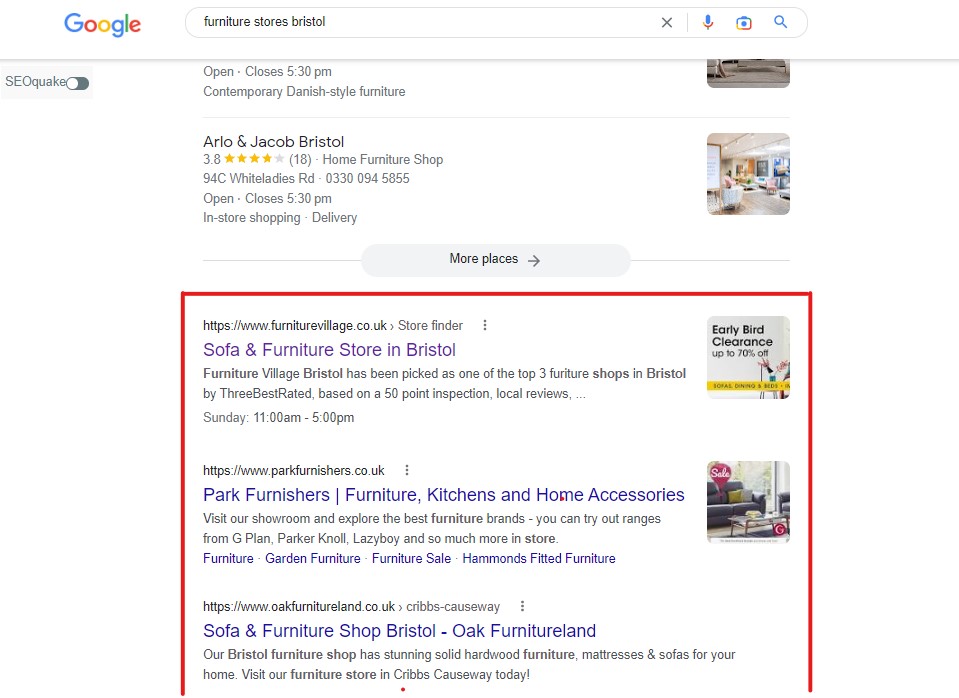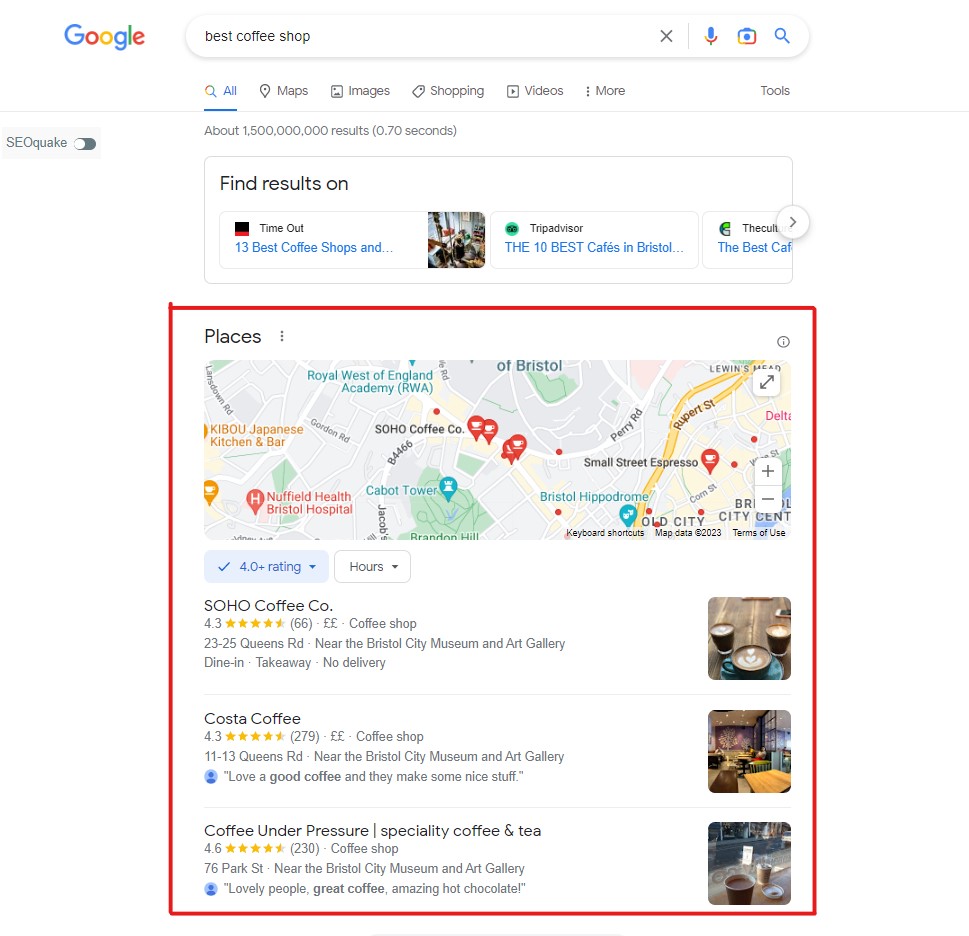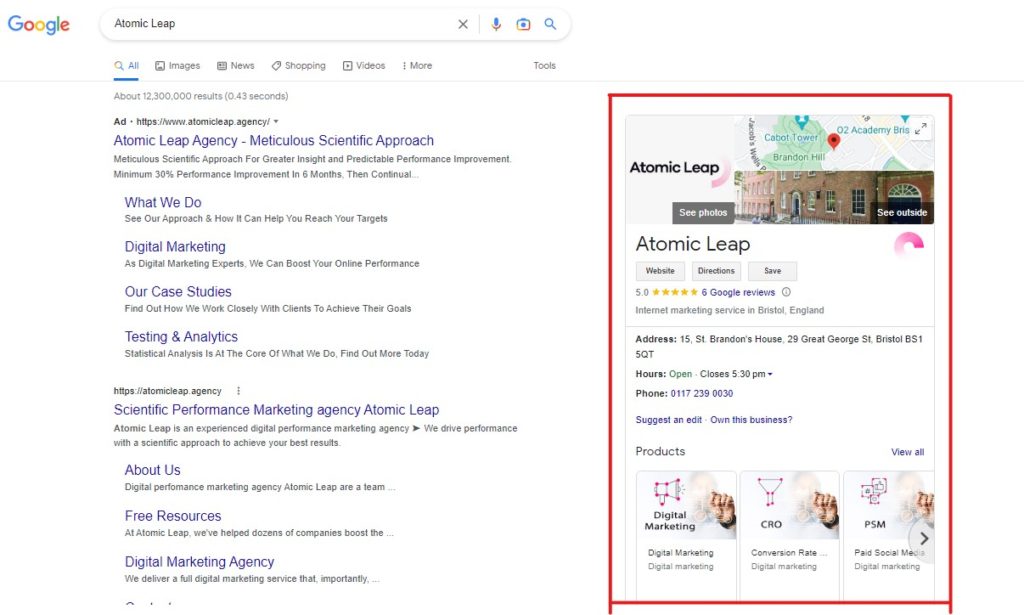Open AI’s Chat GPT & Search GPT aren’t just another search engine. In fact, these AI tools reflect a shift in how people are discovering information. This evolution is vital for businesses to understand, as it directly impacts website visibility and brand presence. By optimising your content for these new AI tools, you can appear in their generative answers and significantly broaden your online reach.
For years, search has been about targeting keywords and being featured in a list of 10 blue links on the search engine results page. Search GPT is a completely different game, it analyses up to 12 results from its underlying search index to generate a single direct answer. Open AI have publically said this index is based on Bing, however across the search marketing industry, we have seen that it also takes information from Google’s search index.
Search marketing has expanded, moving from a directory of links to a direct dialogue with an intelligent system. Open AI’s Chat GPT & Search GPT tools combined are an AI-powered search engine that understands queries and keywords with a new level of depth. Rather than simply matching keywords, it interprets user intent to generate conversational and actionable answers.
A major departure from the traditional search engine results page is the switch from a list of links to an ad-free direct answer. Users of Chat GPT and other AI tools, such as Perplexity, Claude and Gemini are actively trying to trying to bypass the traditional ‘click and learn’ process, where they navigate various links to find information. Instead, they’re looking for an immediate answer to their query.
At the heart of this change to search marketing, is Generative Engine Optimisation, also called GEO. GEO has a goal to get your brand, website, content and expertise cited directly in the long form AI generated response that AI tools present to users. Search marketing success is now about being the trusted source that powers these new search experiences.
How User Behaviour Is Changing with AI tools like Search GPT
A recent study by OpenAI and Harvard on millions of ChatGPT conversations revealed a number of shifts in how people are finding information online, including:
Informational Keywords are Booming
People are moving away from Google for research and writing. The use of generative AI for these tasks has doubled, showing a clear shift in user intent.
It’s Not About Code, It’s About Questions
The vast majority of usage isn’t for programming. It’s for research, decision-making, and general knowledge- the kinds of queries you’d typically see in Google.
More Long-Tail Keyword Questions
Search GPT’s conversational nature makes it a perfect fit for complex, personal, or multi-part questions that would have been difficult to phrase in a traditional search bar.
Essentially, users want direct answers, not just links. They want a conversation, not a click-through journey. With AI search tools, they are getting what they need instantly, which can lead to fewer clicks to websites.
What This Means for Your Business’ Search Marketing?
The primary implication is a potential drop in website traffic for purely informational queries. When SearchGPT provides a complete, well-cited answer, a user might never click a link to your site. This doesn’t mean your content is failing; it means its value is being recognised with a new search algorithm and presented in a new way.
The role of your business’s website content is shifting. It must be an authoritative source that SearchGPT pulls from. Your visibility now depends on being cited and recommended, not just on being ranked. When users turn to AI search tools, their journey starts with an AI-generated answer, not a list of links. Your goal is to be the primary source that the AI digests and synthesises into that direct response.
At Atomic Leap, we’ve found that the traffic our clients receive from AI tools like ChatGPT and SearchGPT is generally of higher quality and converts more effectively. This is because these AI systems act as a pre-qualifying filter, conducting in-depth research and presenting users with a curated, trustworthy summary. By the time a user clicks through to your website, they’ve already had their initial questions answered and have a strong, informed interest in what you offer, leading to more valuable visits and a higher likelihood of conversion. This shifts the focus from attracting a large volume of generic traffic to targeting a smaller number of high-intent, pre-qualified leads. You can explore our agency’s positive digital marketing results for yourself.
While these implications are large, they pose an opportunity:
Long Form Content is King
Search Engine Land’s analysis of Search GPT shows that it consistently favours pulling information from long-form, authoritative content, rather than brand-specific product pages. Search GPT’s AI algorithm doesn’t seem to trust promotional claims and instead will try to find a detailed and complete content that it can use to synthesise an answer from. To be featured, content needs to feature in-depth answers that provide a balanced argument that AI tools can cite.
AI Mentions, Instead of Clicks
Since Search GPT doesn’t display ads, you could say all its results are organic. As such, the goal for your business’ search marketing strategy is not necessarily to get a click to your website any more, but to have your brand accurately mentioned and positively framed as an expert in the AI generated response.
Local SEO is more important than ever
For local businesses, positive online reviews are amplified. Search GPT’s response to local searches pull from sources that reflect credibility, and relies heavily on data from places like Google Maps. So having a strong presence on these platforms, alongside a number of authentic and positive reviews could be the difference between being featured in AI local search results.
What Does This Mean For My Search Marketing Strategy?
The shift to AI search isn’t a threat; it’s a significant opportunity for organic visibility. At Atomic Leap, we’ve developed an internal framework to ensure our clients thrive in this new landscape, focusing on what we call AI Visibility. While we can’t reveal our entire framework, you can get a head start by using out free AI SEO Audit tool. Here’s a look at the tactics we’ll use to adapt your search marketing strategy:
Intent-Centered, Fact-Grounded Content
We’ll move beyond simple keywords to address the real information need behind every query. Our approach focuses on creating content with concise, verifiable facts, using inline citations to demonstrate credibility. We also create content with enough depth to satisfy multi-turn, conversational queries.
Semantic Structure & Rich Data
We’ll make your content machine-readable for AI. This involves using schema markup (like FAQPage or HowTo), natural-language headings that ask the question directly, and logical formatting like lists and tables. This way, AI can easily extract, cite, and act on your content.
Technical Accessibility & Performance
If a crawl bot can’t access your website or page’s content, it can’t rank or be used by AI. We’ll audit your site to fix crawl errors, JavaScript issues, and make sure it meets serach enigne technical standards like Core Web Vitals and mobile-first indexing. Your website’s technical health is the foundation of AI search tools visibility.
Authority, Trust & Entity Signals
AI systems, just like humans, look for credible sources. We’ll strengthen your brand’s EEAT (Expertise, Experience, Authoritativeness, and Trustworthiness) by securing highly relevant backlinks and digital PR partnerships. We will also work to ensure your brand has a strong, consistent presence in knowledge graphs, so AI can confidently ground facts to you.
Adaptive Measurement
The AI landscape is evolving rapidly. We will continuously monitor your brand’s AI citation rates in platforms like Perplexity and Copilot, in addition to Search GPT. We’ll also track other key performance indicators like semantic similarity and informational gain scores to measure the value of our optimisations. This data will allow us to continually refine our strategy and keep you ahead of the curve.
This new era of search marketing is not a threat; it’s a new opportunity for organic visibility. We are actively testing and refining these strategies to make sure your business remains a leader in a world where search is becoming a conversation.
As many of us are aware, Google is “making AI helpful for everyone”. Google is our first stop to information online, and at the forefront of this shift into AI search, is Google AI Mode. More than an update to the SERP, this change to search redefines how users discover and consume information. The AI search marketing industry is poised for continued innovation and expansion as we look ahead.
What Is Google AI Mode?
For decades, Google search focused on finding ten blue links to explore. Whereas, Google’s new AI Mode – currently being rolled out in the US, India and UK search results – doesn’t show links, but presents a rich conversational tone with direct answers, all within the search engine results page.
Complex questions like ‘What are the essential types of liability coverage a care home needs, and what do they protect against?’ or ‘How can families assess the quality of care and resident well-being in different care home settings?’ traditionally, required users to click through a number of different websites as source of information. With AI Mode, Google forms the answer for you, provides a detailed summary and shares follow-up questions, similar to the People Also Ask rich snippet – all of which is displayed in the SERP. The search interface still includes citations and links, but the primary interaction is now with the AI generated answer. Driven by advanced reasoning, a ‘query fan-out’ breaks down complex topics into questions and sub-queries, encouraging users to explore the topic comprehensively and get immediate responses.
How Google AI Mode Works In Search
Google is introducing AI Mode in its search experience, heavily promoting its use as a ‘dive deeper’ button on AI Overviews, a Google distinct AI Mode search button on the US Google homepage and an option to ‘shop with AI Mode’ replacing ‘view more products’ on listings. The Atomic Leap marketing team have seen Google’s AI Mode featured in UK SERPs as well. Expect continued expansion of AI Mode into the SERP.
What Does Google AI Mode Mean for SEO Strategy?
The adoption of conversational and instant search will have implications for user behaviour across organic channels.
Fewer clicks, more instant answers
When Google AI mode provides a comprehensive answer, users may feel less of a need to click through to external websites. This zero click trend is typically affecting user’s clicking behaviour for keyword searches with informational intent. Informational intent keywords are question related – who what when where why and how. If your website’s rankings, traffic and clicks, depend heavily on informational intent keywords, then you might experience a drop in direct organic traffic.
Longer, More Conversational Queries
Voice search has featured in SEO trend predictions for years. Users are becoming more comfortable having conversations with search engines. Gone are the days of short broad keyword phrases, instead users are using natural colloquial language to communicate with search engines. Users are asking full questions or segmenting their questions out into multiple parts. As an agency, we expect an increase in long tail keyword rankings, especially with platforms like ChatGPT Voice Mode and Google AI Mode gaining traction.
Traditional SEO Isn’t Dead
Google AI Mode won’t replace all search channels. Search engines are used for simple keywords with navigational intent, or situations where a user wants to browse and explore multiple sources of information via the traditional ten blue links. Also, if Google AI mode is not confident in an answer then it will default to traditional non-AI search result page.
Growth in Voice & Multimodal Search
As search becomes more conversational, voice search will eventually become more popular. AI Mode’s development may integrate into how Google Assistant or mobile voice searches are answered – i.e. more conversationally with summarised information. Also, if AI Mode is supporting multimodal inputs, like images, spreadsheet or PDF files with users asking questions about them, potentially the future holds the possibility of being able to ask questions whilst filming a video. If this is the case, visuals and other media hosted on a website will play even more of a role in being discovered and understood by Google AI.
How to Optimise for Google AI Mode & Answer Engines?
The most direct consequence of the changes to the SERP and Google’s AI evolving search experience is the recalibration across the SEO industry of how we are reporting. For years the metrics have been the same, impressions and click traffic were an indicator of interest and online visibility. While organic traffic remains an important aspect of a website’s performance, the definition of success of search marketing must evolve with such large upheaval of the search experience.
Website content doesn’t just need to be crawled, discovered, and indexed. Content needs to be definitive, factual and come from an authoritative source that Google’s AI trusts. It’s not about being at the top of the SERP any more, it’s a race to being considered as the source of knowledge on a topic that fuels an intelligent AI generated answer across platforms like AI Overviews and Google AI Mode.
Our Approach for AI Website Optimisation
As an agency, we are not concerned about Google AI Mode, instead we are being proactive, with a data-driven approach. We have developed a proactive AI marketing strategy. Our approach is designed to ensure your website stays visible and impactful in the new world of AI search marketing. Integrated into our approach is traditional SEO principles and best practice, alongside innovative strategies that govern how websites can be recognised by AI agents as experts in an industry.
The future of search is conversational and intelligent. As an agency our process includes a systematic suit-optimise and monitors cycle that starts with a comprehensive Omnichannel AI Audit that looks at keywords, content quality, technical accessibility, off-page authority and assessing your website’s current ‘Answer Engine Readiness’ across multiple AI platforms like Perplexity AI, Bing Copilot, ChatGPT, and Google’s AI Overviews. Next, we focus on optimisation, implementation to refine content, address technical issues, improve link profile and build your knowledge graph presence. Then we continuously track AI citation rates, traffic and keyword ranking fluctuations – Monitoring changes in AI search results and generative AI outputs to adapt our strategies based on new AI developments and search engine algorithm updates.
Our thorough AI website optimisation framework helps brands to navigate and capitalise on new AI-driven transformation with clarity and confidence. Speak to one of the team today for a free initial AI website audit, let’s discover how ready your business is for the future of search marketing.
When conducting an e-commerce SEO audit, it’s essential to follow a comprehensive e-commerce SEO audit checklist to ensure that your online store is optimized for search engines. An SEO audit for e-commerce site involves reviewing various aspects of your website, from e-commerce SEO technical audit elements to on-page optimizations. Here’s a detailed guide on what to check for during an e-commerce SEO audit:
1. Technical SEO
- Website structure and hierarchy.
- URL structure and permalinks.
- Sitemap and robots.txt file.
- HTTPS implementation.
- Page load speed and performance.
- Mobile-friendliness and responsiveness.
- Schema markup for product pages.
2. On-Page SEO
- Title tags, meta descriptions, and header tags (H1, H2, etc.).
- Keyword optimization in product descriptions.
- Image alt tags.
- Canonical tags for duplicate content.
- Internal linking structure.
3. Content Quality
- Product descriptions: Ensure uniqueness and informativeness.
- Blog content: Relevance and quality.
- User-generated content (reviews and ratings).
4. Product Pages
- Unique product descriptions for each item.
- High-quality images with descriptive alt tags.
- Product reviews and ratings.
- Clear pricing and availability information.
5. User Experience (UX)
- Site navigation and organization.
- Mobile optimization and responsive design.
- Checkout process ease and security.
- Site search functionality.
6. Site Speed
- Page load times across devices.
- Image optimization.
- Minimization of HTTP requests.
- Caching and compression.
7. Technical Issues
- Broken links and 404 errors.
- Redirects (301 and 302 redirects).
- Duplicate content issues.
- Use of structured data (schema markup).
8. Local SEO (if applicable)
- Google My Business profile optimization.
- Local keyword targeting.
9. Backlink Profile
- Quality and relevance of backlinks.
- Toxic or spammy backlinks.
10. Conversion Rate Optimization (CRO)
- Checkout process optimization.
- Calls-to-action (CTAs) and buttons.
- Product page layout and design.
- Abandoned cart recovery strategies.
11. Analytics and Tracking
- Google Analytics and Google Search Console setup.
- Tracking and analyzing user behavior.
- Monitoring key performance metrics.
12. Security
- Regular security audits.
- HTTPS implementation.
- Protection against malware and hacking.
13. International SEO (if applicable)
- Hreflang tags for multiple languages and regions.
- Currency and pricing adjustments.
14. Social Media Integration
- Ensure social sharing and integration options are optimized.
15. Legal Compliance
- Privacy policy, terms and conditions, and other legal requirements.
Conducting an e-commerce SEO audit using this e-commerce SEO audit checklist will help you identify areas for improvement, ensure your website’s SEO health, and boost its visibility in search engine rankings.
What tools can you use to conduct SEO audits?
You have several options when it comes to SEO audits:
- Do It Yourself (DIY): Clients with a good understanding of SEO can perform their own audit using the checklist provided. There are many online resources and tools available to assist in the process. Use a tool like Screaming Frog to highlight any technical errors
- Paid Services: Clients can opt for paid SEO audit services provided by various SEO tools and agencies. These services often offer in-depth analysis and recommendations based on the audit results. There are several you can try. Semrush gives you keywords, competitive analysis, article ideas, and a set of other tools. Then there is Ahrefs or Moz.
- Experienced SEO Marketing Agency: You can turn to an experienced SEO marketing agency to conduct the audit. Such agencies can not only perform the audit but also develop the right SEO strategy, improve the website’s structure, analyze competitors for further promotion, and work on improving the site’s position by increasing targeted traffic within a specified timeframe, often within three months.
By choosing the approach that best suits their needs, you can ensure that you e-commerce website is fully optimized for search engines, driving increased organic traffic and improving their online visibility.
ABOUT THE AUTHOR
Nataliia Yuzhaninova is SEO manager of marketing agency Atomic Leap.
LinkedIn: Nataliia Yuzhaninova
Local SEO is a type of search engine optimisation for small and medium businesses that helps to achieve high positions in the search results for geo-specific queries.
Knowing the trends and optimisation principles associated with local search is now becoming a marketing priority for many types of company. That is why we are going to look at some local SEO tips in a moment.
Types of company optimising for local search
- Stores and companies with a physical sales office
- Cafes, restaurants
- Entertainment establishments
- Medical and cosmetic clinics and we are seeing local SEO for dentists
- Beauty salons
For some projects, why local SEO is important is that it’s the only strategy that guarantees the achievement of marketing objectives. This is because of the following:
- Search personalisation. The first positions in the search results are occupied by larger companies and stores, as well as catalogues and aggregators. This is a big reason why local SEO is important for small business.
- Search service algorithms are adapted to the semantic meaning of the search query, and not to key phrases (keyword).
- Search results are adapted to the location of the user who is looking for a particular product or company. This method allows search engines to provide different answers to the same search query sent from different places, which provide results that are closest to the user.
In this blog, as a local SEO expert we will tell you about the advantages of local SEO and what mechanisms work in local SEO as well as how to optimise a site for local search results; in short, we’ll tell you how to dominate local SEO.
Benefits of local optimisation
Local optimisation allows you to:
- Increase the volume of traffic to the site for local low-frequency queries
- Take conversions to the next level
- Gain an edge over larger competitors in your business sector
- Increase your brand awareness
As you can see, they are all good reasons to prioritise search engine optimisation for local business.
Top ranking factors for local SEO

Search results are becoming more and more personalised. One of the factors of personalisation is the location of the user. Google uses maps and quick replies to show information from companies that are geographically closer to the searcher’s location. So all of the following local SEO ranking factors are important when considering how to improve local SEO.
- The physical address of the company. The closer you are to the user at the time of the search, the higher the probability of getting into their local results.
- Availability of your company in Google My Business, Google Maps, Bing Places with the right category and description.
- Quality link profile is good for local SEO UK.
- Optimised URL, title tags, headers, meta description, and content for geo-requested queries.
- Citation of the brand or mention of the company in local media, forums and blogs.
- Registration in local directories and services helps for local SEO B2B or B2C.
- The same NAP (name, address, phone) for all sites and services where your company is listed.
- Reviews about the company in various sources – their quantity, quality and regularity of writing.
- Behavioural factors. Clicks on the company card, clicks on phone numbers.
- Social signals about the activity of the company in social networks.
Local search result types
There are three types of ranking results for geo-specific queries:
- Local organic results.

- Google Local Map Pack is the top three results from Google Maps.

- Local Knowledge Graph – usually this is the results for direct queries.

And you can dominate each of these above.
How to improve local SEO and dominate the SERPs

Here are 11 simple but useful tips that we use in our own SEO agency to help you improve your local SEO and make it more relevant to search engines:
- When generating search results for a geo-dependent query, search engines take into account NAP (name, address, phone). Consistent contact information on all sites that provide information about the company will allow search bots to accurately identify your brand.
- List your business on Google with a free Business Profile (formerly Google My Business) and on Bing Places. In addition to the fact that services allow you to get to top positions in the search results, they themselves can be a great source of traffic.
- Work on the contact page on your site and mark it up with semantic tags so that search engines interpret the data correctly. Add microdata LocalBusiness (schema.org) – specify as many properties as possible: from the address and company name to geographic coordinates, opening hours, branches, reviews and links.
- Meta tags like title, description, heading tags H1, H2 should contain the name of the city and/or district where your enterprise is located or operates.
- Work on site content for local keywords. All local queries should have a pronounced geo-dependence and a clear regional intent. Google doesn’t rank websites, it ranks pages. Therefore, you need to create separate landing pages for specific locations, avoiding duplicates of the main content.
- Optimise content for voice search using more long-tail keywords.
- Image optimisation. It is necessary to prescribe the name of the city, district, street in the Alt attribute, which allows for ranking when searching for a product by image.
- Generate as many reviews as possible.
- Publish posts and reviews on social networks, they will increase local brand awareness and attract additional traffic to the site.
- List your business on local business directories such as Yelp, Foursquare, MapQuest, and Yellow Pages. You need to choose the most suitable sites, log in, add information about your business and a link to your website.
- Get high-quality backlinks from regional sites.
Help with local SEO optimisation

We hope you found that local SEO checklist useful. By following these tips, you will make your website and local business more visible to search engines. If you would like us to manage it all for you though, please do not hesitate to contact our local SEO solutions team and we can tell you more. Or get in touch even if you just have a further question around how to optimise your website for local search. We would love to share our experience in local SEO strategy with you.
If you found this article helpful, share the link with people you know. They might also benefit from knowing about local SEO.
ABOUT THE AUTHOR
Nataliia Yuzhaninova is SEO manager of marketing agency Atomic Leap.
LinkedIn: Nataliia Yuzhaninova

